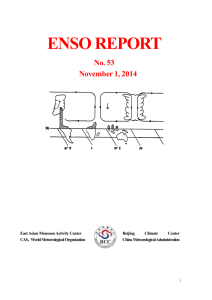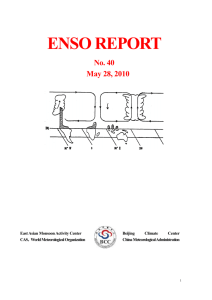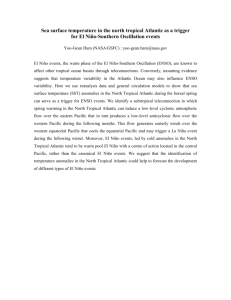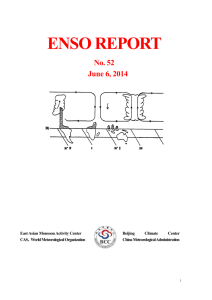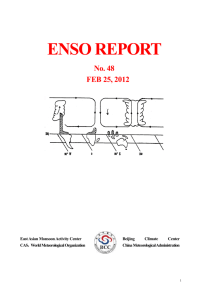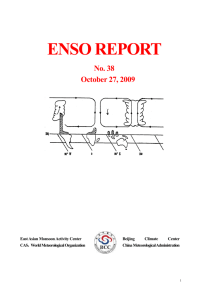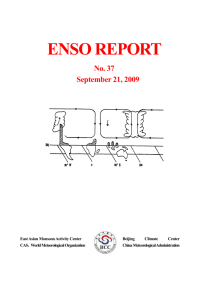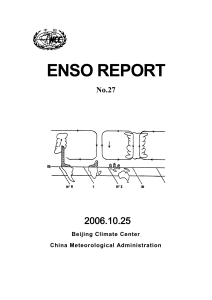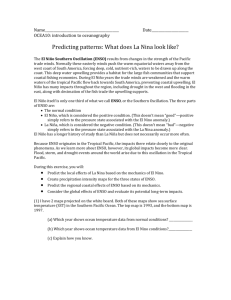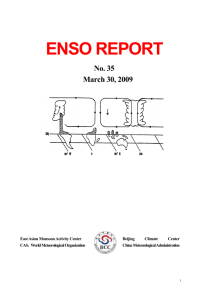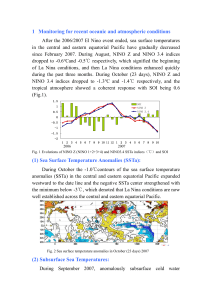English
advertisement
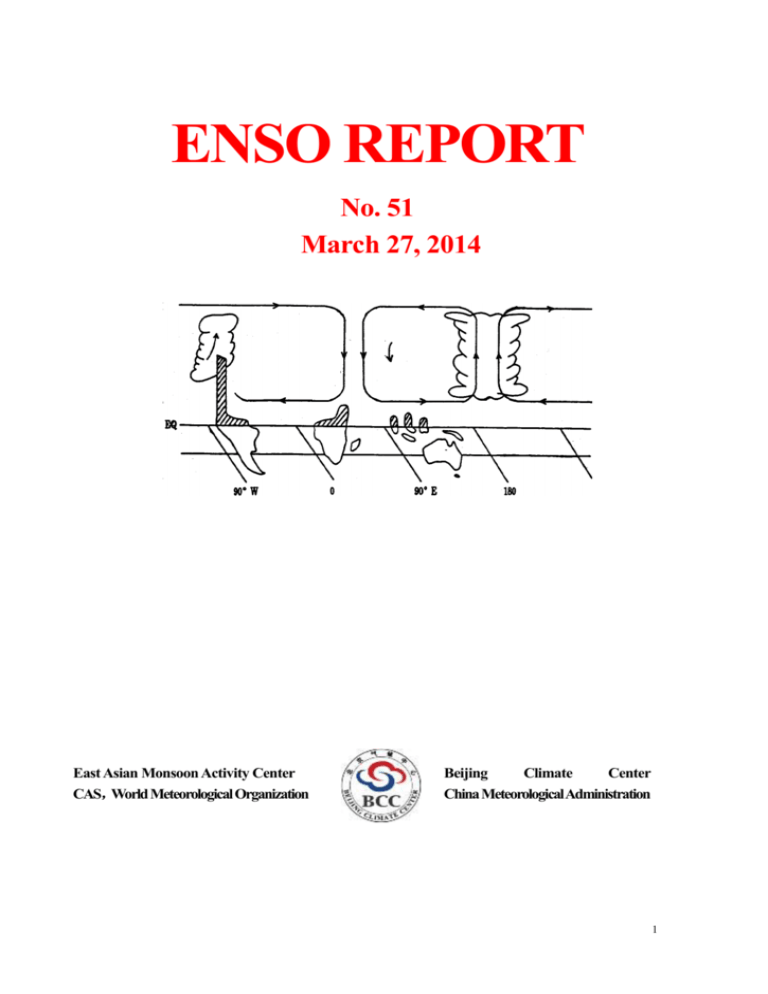
ENSO REPORT No. 51 March 27, 2014 East Asian Monsoon Activity Center CAS,World Meteorological Organization Beijing Climate Center China Meteorological Administration 1 The positive subsurface temperature anomalies increased rapidly across the central - eastern equatorial Pacific and an El Nino event will develop during the summer 1. Recent monitoring on ENSO evolution a) Sea surface temperature (SST) anomalies The weak below-average sea surface temperatures (SSTs) in the central-eastern equatorial Pacific, which began in late 2012, decreased gradually after January 2013, and ended in March 2013. Since April 2013, below-average SSTs have developed in the central-eastern equatorial Pacific again. After that, weak cold conditions dominated over most central-eastern equatorial Pacific. Recently, the weak below-average SSTs over the central-eastern equatorial Pacific decreased rapidly, and Nino Z index was -0.19℃ by the first 23 days of March 2014 (Fig. 1). The distribution of SST anomalies showed that below-average SSTs decreased in the central equatorial Pacific Ocean and above-average SSTs appeared in the eastern equatorial Pacific Ocean (Fig. 2). Fig.1 Evolution of Nino Z, Nino 3.4 SSTA indices (unit: ℃) and SOI (SSTA and SOI indices in Mar. 2014 are calculated for the first 23 and 24 days, respectively) 2 Fig.2 Sea surface temperature anomalies in March (the first 24 days) 2014 (unit: ℃) b) Subsurface temperatures A significant downwelling oceanic Kelvin wave led to the increases of oceanic heat content and positive subsurface temperature anomalies across the central-eastern equatorial Pacific (Fig. 3). Fig.3 Sub-surface temperature departures in the equatorial Pacific on March 19, 2014 (unit: ℃, from NOAA) c) Southern Oscillation The Southern Oscillation shifted from positive phase to negative phase in February 2014, and then enhanced in March 2014. The Southern Oscillation Index (SOI) of the first 24 days in March was -1.0 (Fig. 1). d) 850hPa Zonal wind At 850hPa, the westerly anomalies developed in the western equatorial Pacific and stirred up oceanic warm Kelvin waves propagating eastward along thermocline, resulting above-average SSTs lifted up significantly in the central-eastern equatorial Pacific. Recently, 3 the central-eastern equatorial Pacific was controlled by the westerly anomalies and favored the equatorial warm water of SSTs in the central-eastern Pacific (Fig. 4). Fig. 4 Time-longitude section of pentad 850hPa zonal wind anomalies averaged in 5ºS-5ºN (Units: m/s, from NOAA) 2. ENSO Diagnosis and outlook By the late March 2014, SSTs of Nino regions increased and the positive SSTs anomalies covered large portions of it, and the subsurface warm water dominated the eastern equatorial Pacific. Meanwhile twice strongly westerly burst events occurred in early the year, which led to weaken the northeasterly trade wind and intensify the convection activities near dateline. In addition, the studies denoted that both the past winter SST anomalies in the northwestern Pacific and the air temperature differences over the eastern and western tropical Pacific indicated a possible El Niño event since summer 2014. Most models predict El Niño conditions will start during the Northern Hemisphere summer 2014. The national consultation meeting on ENSO monitoring and outlook’ was hosted by BCC (Beijing Climate Center) on March 21th, 2014. Based on discussions about recent oceanic and atmospheric conditions and characteristics of ENSO cycle, and referred to the 4 ENSO models’ prediction results, the experts from Institute of Atmospheric Physics, National Marine Environmental Forecasting Center, Peking University, Chinese Academy of Meteorological Science, and BCC reached a consensus that the ENSO-neutral with slightly cold conditions is expected to transition to ENSO-neutral with slightly warm conditions in the coming rest spring, and which is more likely to reach the El Niño conditions in summer 2014, and furthermore shape to an El Niño event. Considering frequent occurrence of rapidly adjustment in the tropical Pacific climate during spring season, we will closely monitor the ENSO status and issue our updating prediction on it. 5 BCC operational definitions for El Niño and La Niña Event (condition) El Niño (La Niña) event: which is characterized by a positive(negative) sea-surface temperature departure from normal (for the 1971-2000 base period) in NINO Z (NINO 1+2+3+4) greater (less) than or equal to 0.5℃ (-0.5℃) for at least 6 consecutive months (allowing below (above) 0.5℃(-0.5℃) for only one month) . BCC considers El Niño (La Niña) conditions to occur when the monthly NINO Z index greater (less) than or equal to 0.5℃ (-0.5℃) along with consistent atmospheric features. And, these anomalies must also be forecasted to persist for at least 3 consecutive months. *References 1. On Indices and Indicator of ENSO Episodes, 2000, Acta Metrological Sinica, 58(1): 102-109 2. Redefining ENSO Episode on Changed Reference, 2005, Journal of Tropical Meteorology,2005, 21(1): 72-78 Distribution of the NINO regions for ENSO monitoring Editor: Si Dong Han Rongqing Technical assistant: Tang Jinyue Chief Editor: Zhou Bing Gao Hui Sun Chenghu BCC’s ENSO monitoring website: http://cmdp.ncc.cma.gov.cn/Monitoring/enso.php 6

